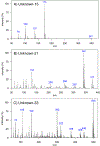Nontargeted Screening of Halogenated Organic Compounds in Bottlenose Dolphins (Tursiops truncatus) from Rio de Janeiro, Brazil
- PMID: 28055195
- PMCID: PMC6263163
- DOI: 10.1021/acs.est.6b04186
Nontargeted Screening of Halogenated Organic Compounds in Bottlenose Dolphins (Tursiops truncatus) from Rio de Janeiro, Brazil
Abstract
To catalog the diversity and abundance of halogenated organic compounds (HOCs) accumulating in high trophic marine species from the southwestern Atlantic Ocean, tissue from bottlenose dolphins (Tursiops truncatus) stranded or incidentally captured along the coast of Rio de Janeiro, Brazil, were analyzed by a nontargeted approach based on GC×GC/TOF-MS. A total of 158 individual HOCs from 32 different structural classes were detected in the blubber of 4 adult male T. truncatus. Nearly 90% of the detected compounds are not routinely monitored in the environment. DDT-related and mirex/dechlorane-related compounds were the most abundant classes of anthropogenic origin. Methoxy-brominated diphenyl ethers (MeO-BDEs) and chlorinated methyl- and dimethyl bipyrroles (MBPs and DMBPs) were the most abundant natural products. Reported for the first time in southwestern Atlantic cetaceans and in contrast to North American marine mammals, chlorinated MBPs and DMBPs were more abundant than their brominated and/or mixed halogenated counterparts. HOC profiles in coastal T. truncatus from Brazil and California revealed a distinct difference, with a higher abundance of MeO-BDEs, mirex/dechloranes and chlorinated bipyrroles in the Brazilian dolphins. Thirty-six percent of the detected HOCs had an unknown structure. These results suggest broad geographical differences in the patterns of bioaccumulative chemicals found in the marine environment and indicate the need to develop more complete catalogs of HOCs from various marine environments.
Figures





References
-
- UNEP. The 9 new POPs; 2010; Vol. 2008.
-
- European Court of Justice. Commission Decision 010/571/EU. Off. J. Eur. Union 2010, 56, 30–36.
-
- Alonso MB; Feo ML; Corcellas C; Vidal LG; Bertozzi CP; Marigo J; Secchi ER; Bassoi M; Azevedo AF; Dorneles PR; et al. Pyrethroids: a new threat to marine mammals? Environ. Int. 2012, 47, 99–106. - PubMed
-
- Gago-Ferrero P; Alonso MB; Bertozzi CP; Marigo J; Barbosa L; Cremer M; Secchi ER; Domit C; Azevedo A; Lailson-Brito J; et al. First determination of UV filters in marine mammals. Octocrylene levels in Franciscana dolphins. Environ. Sci. Technol. 2013, 47, 5619–5625. - PubMed
-
- Blunt JW; Copp BR; Hu WP; Munro MH; Northcote PT; Prinsep MR Marine natural products. Nat Prod Rep 2009, 26, 170–244. - PubMed
Publication types
MeSH terms
Substances
Grants and funding
LinkOut - more resources
Full Text Sources
Other Literature Sources
Miscellaneous

